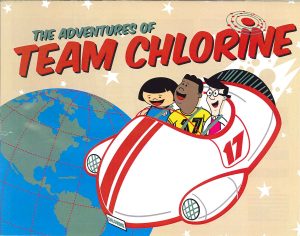Hydrogen is an important chemical for the climate neutral economy. Currently Europe is defining screening criteria for hydrogen but does not yet consider chlor-alkali electrolysis – a green process.
The European chlor-alkali sector produces some 0.27 million tonnes of hydrogen as a by-product of the highest purity. For this, chlor-alkali electrolysers use less electricity and emit less CO2 to produce 1kg of hydrogen than water electrolysis. Euro Chlor has developed this illustrative infographic to highlight the potential of the chlor-alkali sector as a green hydrogen producer for Europe.
Learn more about hydrogen from European chlor-alkali production.
On 17-18 November, the WCC Global Safety Team held its online Safety Seminar. The seminar contained several presentations from the members. In total, around 80 people from all global regions attended one or both events.
The Seminar included topics such as Jack Rabbit and the effect on the modelling of chlorine releases, the WCC Cardinal rules, accidental mixing, lessons learned, etc. The presentations have been sent to the participants in addition to the recordings from the sessions for onward distribution to those who could not attend. If you are interested in the topics presented, please send an email to Ton Manders, Euro Chlor Technical & Safety Director.
The American Chemistry Council’s Chlorine Chemistry Division has released an excellent new video, focusing on the key role that chlorine chemistry plays in protecting drinking water.
It shows how chlorine gets rid of bacteria, viruses, and parasites from water to keep us healthy. It also keeps drinking water safe as it makes the journey from the water treatment facility to our glass.
This video is part of a wider series that shows other benefits of chlorine chemistry and how it truly is the ‘Element of Surprise’.
More on this can be found via the website – https://www.elementofsurprise.org

Chris Allen from the European Commission praised chlor-alkali’s efforts in the mercury phase out…
Euro Chlor held its tenth Technical Conference & Exhibition in May 2017; sharing best practices and new technological developments in the areas of health, safety and environmental protection.
Chairman of the Euro Chlor Management Committee Dieter Schnepel (Dow Deutschland) opened this Berlin edition of the Conference, welcoming 360 participants from 34 countries to the theme: sustainable chlorine production and the road to continuous improvement. He highlighted that our industry will continue to develop in the years ahead of us, as not only will mercury technology for the production of chlorine, caustic and hydrogen soon disappear, but our high energy demand – inherent to the chlor-alkali production – means we need to find increasingly efficient and sustainable ways of producing energy.
These and many other topics returned during the conference and in the exhibition, with 46 exhibitors presenting their equipment and those services they offer to our industry. Apart from the mercury challenge, issues like the effects of EMF directives on our industry and the protection of our worker’s physical and mental health were some of the many discussed subjects. Within the mercury context, Christopher Allen, Head of the Industrial Emissions and Safety Unit at the European Commission, presented the regulatory framework on the mercury subject. He also expressed his appreciation for our industry’s collaboration, openness and willingness to share mercury information.
This global, collaborative concept closed out the conference where Euro Chlor executive director Dolf van Wijk stated that “transparency and working together is one of our shared key values”.

The theme of this event is “Sustainable chlorine production; the road to continuous improvement” and participation is open to both Euro Chlor members and non-members alike.
Given the global chlor-alkali industry emphasis on safety and the environment and, as for previous events, health, safety and environmental protection in the production, use and transport of chlorine will constitute the core of the Conference. There will also be additional attention on those technologies and services that safely, sustainably and responsibly drive the chlor-alkali industry forwards.
In parallel with the Conference, an Exhibition will give engineering companies, equipment manufacturers and service suppliers the opportunity to showcase their expertise and the benefits they can offer to the participants.
At the 2014 event in Madrid, over 370 delegates from 34 countries from around the world attended and it is hoped that participation will be even higher this year!
This new Conference will be held at the Maritim Hotel Berlin, close to Postdamer Platz in Berlin, and accommodation for the participants will be available in the hotel itself.
You can find detailed information on the Conference program, exhibition participation and registration requirements on this dedicated website: http://eurochlor2017.org/.
Additional information can be obtained from contact[at]eurochlor2017.org.
Contact Euro Chlor: Chantal Peeters, Technical Assistant, cpe[at]cefic.be , tel. +32 2 676 74 01
In September 2015, the new UN Agenda for Sustainable Development was adopted, coming into force on 01 January 2016. The 17 Sustainable Development Goals (SDGs) contain a very important one, SDG #6 (Sustainable management of water and sanitation for all) which is of direct relevance to chlorine. The importance of SDG #6 was highlighted during the 2016 World Water Week, which this year took place on 27 August – 01 September.
Despite some progress in achieving the SDGs being made, the UN Secretary General report of June 2016, highlighted that some areas for improvement still remain. For example by 2030, 663 million people could still have no access to an improved water source and 2.4 billion people may still have no access to improved sanitation. This must change over the next 15 years and efforts to do this have begun by making the SDG indicators more specific and measurable.
It is here that chlorine plays a vital role! For example, the SDG indicators call for improved drinking water sources that are located on the premises, available when needed and compliant with water quality standards.
Chlorine is already well known to be a powerful tool in providing such safe supplies. For example, in 2012 “Rapid Assessment of Drinking-water Quality: A Handbook of Implementation” (WHO/UNICEF) recommended the use of the chlorine residual of ≥ 0.2 mg/l as a key parameter to check for in all samples from disinfected supplies (e.g. at treatment works, in distribution and in households). This residual helps to protect the microbial quality of the water in distribution and storage in order to safeguard human health.
This residual is not the only benefit of using chlorine though. Chlorine’s affordability and proven, effective nature, alongside it’s scalability and ease of measurability using simple test-strips will all contribute to achieving the UN SDGs over the coming years.
Indeed, such positive impacts are already seen in Haiti, where a network of ‘Chlorine Banks’ is helping to protect over 900,000 people in rural communities from fatal waterborne diseases like cholera for as little as 20₵ per family per month!
September 26 marked the 108th anniversary of the first continuous use of chlorine to disinfect a public drinking water supply in the United States, notes a Water Quality & Health Council (WQ&HC) Perspectives article (September 23). In an extensive feature story, the WQ&HC notes that in 1908, “chlorine chemistry’s germ-defeating properties were demonstrated in drinking water in two very different settings in the United States. ”First, a test of chlorination improved the quality of animal feed water, drawn from a highly polluted stream in Chicago’s Union Stockyards”, states the story. “Days later, in Jersey City, chlorinated water was supplied for the first time on a permanent basis to a large U.S. municipality. The results included a dramatic decline in the local typhoid fever rate and a water supply that, according to a 1928 sanitary engineering report, ‘is not only of a high sanitary quality, but…it compares favorably with the best in the country,’” according to the story. “Good news traveled quickly and within a decade, drinking water chlorination spread to nearly every large city in the country. It has been called ‘a tremendous boon in the safeguarding of public health all over the world and is probably the most important and efficient sanitary measure of protection ever introduced.’” Contact: Mary Ostrowski, 1-202-249-6705.
 A fun and colourful new activity book and website were released today by the Chlorine Chemistry Division of the American Chemical Council.
A fun and colourful new activity book and website were released today by the Chlorine Chemistry Division of the American Chemical Council.
Designed by Meaghan Groah of the ACC, this wonderful new book and website is for children of all ages. It helps to educate on how chlorine is a positive part of our daily lives that is present in important products and applications from all over the world. From solar panels to herbicides, modern plastics to protecting metal, the book is full of exciting stories that everyone can enjoy. You can even try learning about chlorine whilst colouring in the pictures online!
Check out the exciting adventures of Team Chlorine via the website teamchlorine.org!
The UN is working to prevent an outbreak of deadly cholera in South Sudan; an area which has been in crisis since late 2013.
It is suspected that at the moment, nearly 150 people in South Sudan already have cholera. Many people area already in refugee camps but wider access to safe, clean drinking water is still difficult due to the conflict. Whilst UNICEF is delivering safe drinking water, it is challenging to provide medical supplies, sanitation and to raise community awareness, all of which are also essential in preventing an epidemic.
In an attempt to protect the population of the South Sudan as a whole, the UN Mission (UNMISS) and their partners are continuing to supply daily water supplies. This water is treated with chlorine in order to disinfect the water and keep it free from harmful microorganisms, such as those that cause cholera.
This year there have been many high-profile flooding events in North America, Europe and South Asia. Alongside the terrible loss of human life and property, it is essential that the clean-up begins soon after the event to prevent further loss of life due to water-borne disease.
According to a recent article by the Water Quality and Health Council (WQ&HC), it should be assumed that all flood waters are contaminated with such diseases. As such, once the flood waters have been removed and the affected areas are dry and clear of surface dirt/ debris, a disinfecting solution of water and chlorine bleach should be used. Wearing gloves and protective equipment should also help protect people from flood water splashes and subsequent disease whilst cleaning.
The WQ&HC recommend that the bleach solutions should contain 3/4 cup (~150 ml) regular strength chlorine bleach or 1/2 (~120ml) cup concentrated bleach to one US gallon (around 3.8 l of water) to disinfect walls, floors and other surfaces. Leaving such surfaces wet for at least 10 minutes will help correct disinfection. Also replacing the bleach solution as it becomes cloudy will help reduce the chance of microbial contamination.